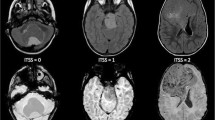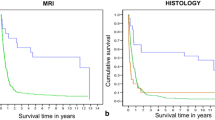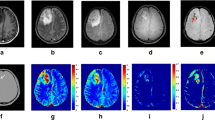Abstract
MRI studies at 1.5 T of 38 patients with histologically confirmed astrocytomas were reviewed to search for a relationship of signal intensity with grade of malignancy, rediotherapy used for recurrent tumours and calcium deposits in surgical specimens. Signal intensity of tumours compared with normal brain was rated on a scale of 1 to 5 on T1- and T2-weighted images. Surgical specimens of each tumour were graded histopathologically on a scale of I to III and examined for calcium deposits. CT scans were searched for evidence of calcification. The majority of astrocytomas appeared hypointense on T1-weighted and hyperintense on T2-weighted images. Of 18 tumours with increased signal on T1-weighted images, grade II were prevalent, followed by calcified astrocytomas. Among 14 tumours with decreased signal on T2-weighted images the order was similar, but the ratio of high-grade to low-grade tumours did not differ in relation to signal intensity, while on T1-weighted images the ratio was higher in the group with increased signal intensity. A high grade of malignancy and microcalcifications were associated with an increased signal intensity of astrocytomas on T1-weighted sequences without contrast agent. The above factors did not influence significantly the signal intensity on T2-weighted images.
Similar content being viewed by others
References
Kaplan RD, Coons S, Drayer BP, Bird CR, Johnson PC (1992) MR characteristics of meningioma subtypes at 1.5 tesla. J Comput Assist Tomogr 16: 366
Kollias SS, Barkovich AJ, Edwards MSB (1991–2) Magnetic resonance analysis of suprasellar tumors of childhood. Pediatr Neurosurg 17: 284
Zimmerman RA (1991) Imaging of adult central nervous system primary malignant gliomas. Cancer 67: 1278
Percy AK, Elveback LR, Okazaki H, Kurland LT (1972) Neoplasms of the central nervous system: epidemiologic considerations. Neurology 22: 40
Vertosick FT Jr, Selker RG, Arena VC (1991) Survival of patients with well-differentiated astrocytomas diagnosed in the era of computed tomography. Neurosurgery 28: 496
Kawano N (1991) Pleomorphic xanthoastrocytoma (PXA) in Japan: its clinico-pathologic features and diagnostic clues. Brain Tumor Pathol 8: 5
Laws ER Jr, Taylor WF, Clifton MB, Okazaki H (1984) Neurosurgical management of low-grade astrocytoma of the cerebral hemispheres. J Neurosurg 61: 665
Castillo M, Scatliff JH, Bouldin TW, Suzuki K (1992) Radiologic-pathologic correlation: intracranial astrocytoma. AJNR 13: 1609
Tervonen O, Forbes G, Scheithauer BW, Dietz MJ (1992) Diffuse fibrillary astrocytomas: correlation of MRI features with histopathologic parameters and tumor grade. Neuroradiology 134: 173
Earnest F IV, Kelly PJ, Scheithauer BW, Kall BA, Cascino TL, Ehman R, Forbes GS, Axley P (1988) Cerebral astrocytomas: histopathologic correlation of MR and CT contrast enhancement with stereotactic biopsy. Radiology 166: 823
Tsuruda JS, Kortman KE, Bradley WG, Wheeler DC, Van Dalsenn W, Bradley TP (1987) Radiation effects on cerebral white matter: MR evaluation. AJNR 8: 431
Tsuruda JS, Bradley WG (1987) MR detection of intracranial calcification: a phantom study. AJNR 8: 1049
Perentes E, Rubinstein LJ (1987) Recent applications of immunoperoxidase histochemistry in human neuro-oncology. Arch Pathol Lab Med 111: 796
VandenBerg SR (1992) Current diagnostic concepts of astrocytic tumors. J Neuropathol Exp Neurol 51: 644
Hicks RJ, Hesselink JR, Wismer GL, Davis KR (1990) Brain: neoplasia. In: Edelman RR, Hesselink JR (eds) Clinical magnetic resonance imaging. Saunders Philadelphia, pp 448–482
Wehrli FW, MacFall JR, Glover G, Grigsby N, Haugton V, Johanson J (1984) The dependence of nuclear magnetic resonance (NMR) image contrast on intrinsic and pulse sequence timing parameters. Magn Reson Imaging 2: 3
Wehrli FW, MacFall JR, Newton H (1984) Parameters determining the appearance of NMR images. In: Newton TH, Potts DG (eds) Advanced imaging techniques. Clavadel, San Anselmo, CA
Englund E, Brun A, Larsson EM, Györffy-Wagner Z, Persson B (1986) Tumours of the central nervous system: proton magnetic resonance ralaxation times T1 and T2 and histopathologic correlates. Acta Radiol Diagn 27: 653
Ngo FQ, Bay JW, Kurland RJ, Weinstein MA, Hahn JF, Glassner BJ, Wooley CA, Dudley AW Jr, Ferrario CM, Meaney TS (1985) Magnetic resonance of brain tumors: considerations of imaging contrast on the basis of relaxation time measurements. Magn Reson Imaging 3: 145
Lundbom N, Brown RD III, Koenig SH, Lansen TA, Valsamis MP, Kasoff SS (1990) Magnetic field dependence of 1/T1 of human brain tumors: correlations with histology. Invest Radiol 25: 1197
Spiller M, Brown RD III, Duffy KR, Kasoff SS, Koenig SH, Lansen TA, Rifkinson-Mann S, Tenner MS, Calsamis MP (1991) Characterization of tumors of human CNS by relaxometry, including cross relaxation. In: Tenth annual meeting of the Society of Magnetic Resonance in Medicine. Book of Abstracts, vol 2, p 684
Englund E, Brun A, Györffy-Wagner Z, Larsson E-M, Persson B (1986) Relaxation times in relation to grade of malignancy and tissue necrosis in astrocytis gliomas. Magn Reson Imaging 4: 425
Brant-Zawadzki M, Kelly W (1987) Brain tumors. In: Brant-Zawadzki M, Norman D (eds) Magnetic resonance imaging of the central nervous system. Raven Press, New York, p 151
Iwama T, Yamada H, Sakai N, Andoh T, Nakashima T, Hirata T, Funakoshi T (1991) Correlation between magnetic resonance imaging and histopathology of intracranial glioma. Neurol Res 13: 48
Dean BL, Drayer BP, Bird CR, Flom RA, Hodak JA, Coons SW, Carey RG (1990) Gliomas: classification with MR imaging. Radiology 174: 411
Watanabe M, Tanaka R, Takeda N (1992) Magnetic resonance imaging and histopathology of cerebral gliomas. Neuroradiology 34: 463
Henkelman RM, Watts JF, Kucharczyk W (1991) High signal intensity in MR images of calcified brain tissue. Radiology 179: 199
Dooms GC, Hecht S, Brant-Zawadzki M, Berthiaume Y, Norman D, Newton TH (1986) Brain radiation lesions: MR imaging. Radiology 158: 149
Author information
Authors and Affiliations
Additional information
Correspondence to: B. Góraj
Rights and permissions
About this article
Cite this article
Góraj, B., Spiller, M., Valsamis, M.P. et al. Determinants of signal intensity in MRI of human astrocytomas. Eur. Radiol. 5, 74–82 (1995). https://doi.org/10.1007/BF00178085
Received:
Revised:
Accepted:
Issue Date:
DOI: https://doi.org/10.1007/BF00178085




